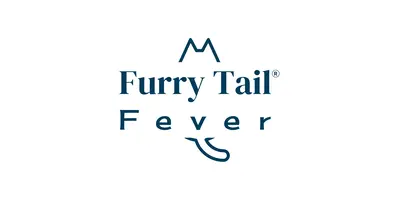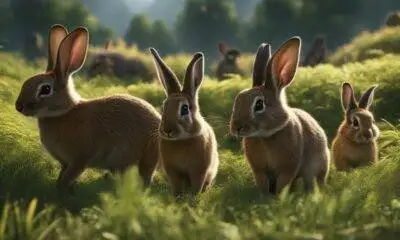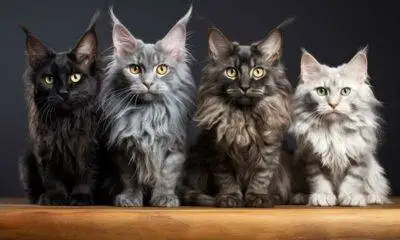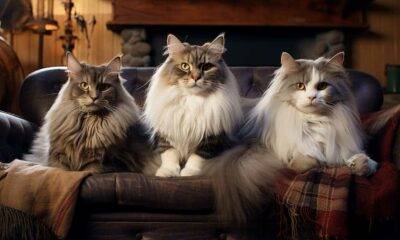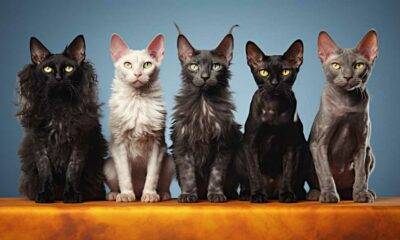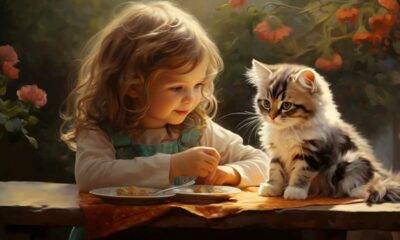cat health
15 Telltale Indicators of Feline Dental Disease

15 Telltale Indicators of Feline Dental Disease
Let’s discuss the fifteen signs of dental disease in cats that will assist you in ensuring your pet’s oral health. Being an attentive pet owner involves being alert for these signs.
Recognizing the significance of dental care and keeping an eye on your cat’s oral health can help stave off serious dental issues. Just like us, cats can also fall prey to dental diseases, which can lead to discomfort and impact their general health.
Observing physical signs such as bad breath or swollen gums, along with behavioral shifts like pawing at the mouth or difficulty in eating can help you address dental issues early.
We’re about to delve into these fifteen signs, arming you with the knowledge to ensure top-tier dental care for your cat.
Understanding Feline Dental Health
Understanding Feline Dental Health
Maintaining your cat’s dental health is more than just keeping their smiles bright; it’s an essential part of their overall health. Recognizing the signs of feline dental disease is key to preventive care. Regular upkeep of your cat’s dental hygiene and routine professional cleanings play a significant role in warding off dental issues.
Dental diseases in cats can present in several ways. For example, you might notice foul breath, inflamed or bleeding gums, difficulty while eating, or excessive salivation. Changes in behavior like increased irritability or aggression could also indicate that your cat is experiencing dental discomfort.

Tartar accumulation, gingivitis, and tooth decay are common occurrences. These issues can escalate into more serious conditions if not addressed promptly. A routine that includes regular brushing of your cat’s teeth, giving them dental-friendly treats, and arranging professional dental cleanings can go a long way in preserving their dental health.
Recognizing the Importance of Dental Care
Taking Care of Your Cat’s Dental Health
Paying attention to your cat’s dental health matters. When it comes to your beloved pet, preventing dental diseases is a significant part of maintaining both their oral health and overall well-being. Understanding the importance of dental health makes you a more effective pet owner, capable of addressing your cat’s needs and enhancing their longevity.
Regular dental maintenance, which includes brushing your cat’s teeth and arranging for regular dental visits, is a key component in keeping dental ailments like periodontal disease and tooth decay at bay. Ignoring dental health could result in grave repercussions such as discomfort, infections, and even damage to vital organs.
Common Dental Diseases in Cats
Don’t turn a blind eye to your cat’s dental health. Ignoring it can expose them to common dental ailments that can cause discomfort, pain, and potentially lead to other health problems if they are not addressed promptly. Here’s a quick run-down of some widespread dental issues in cats, their descriptions, and treatments:
| Dental Disease | Description | Treatment |
|---|---|---|
| Periodontal Disease | Inflammation of gums and tooth support structures | Dental cleaning, antibiotics, tooth extraction |
| Tooth Resorption | Progressive destruction of tooth structure | Tooth extraction, pain management |
| Gingivitis | Inflammation of gums | Dental cleaning, antibiotics |
| Feline Stomatitis | Severe inflammation of the mouth | Dental cleaning, antibiotics, tooth extraction |
To keep these dental diseases at bay, ensuring good dental hygiene for your cat is key. Get into the habit of brushing their teeth regularly, use toothpaste that’s safe for cats, and consider dental treats or toys that promote dental health. It’s also wise to schedule regular dental check-ups with your vet for early detection and treatment of dental problems.
Being aware of these common dental diseases in cats is just the first step. The next step is knowing how to spot these issues.
Physical Indicators of Dental Disease
Keeping an Eye on Your Cat’s Dental Health

It’s a good idea to routinely inspect your cat’s mouth for signs of dental disease. One sign to watch for is tooth discoloration, such as yellow or brown stains on your cat’s teeth. This could indicate dental disease.
Dental X-rays are another valuable tool in spotting dental issues. These images can uncover unseen problems like tooth decay, root abscesses, or bone loss, providing a thorough perspective of your cat’s dental condition. They’re particularly beneficial because they can spot issues that mightn’t be immediately visible.
Through consistent check-ups of your cat’s mouth and the use of dental X-rays when necessary, you can detect dental disease in its early stages and keep your cat’s mouth healthy.
As a vet once said, ‘Prevention is better than cure, especially when it comes to our pets’ health.’ So, it’s worth the effort to monitor your cat’s dental health closely.
Behavioral Changes Indicating Dental Disease
Observing Your Cat’s Actions to Detect Dental Problems
Be mindful of any changes in your cat’s usual actions, as these could be indicators of underlying dental issues. Cats may display changes in their behavior as a way to communicate that they’re dealing with dental discomfort. For instance, if your cat has started to avoid specific foods or is taking longer to finish their meals, this could be indicative of oral discomfort. Similarly, excessive drooling or frequent pawing at the mouth could point to the same problem.
Changes in a cat’s demeanor, such as heightened irritability, uncharacteristic aggression, or an increase in reclusive behavior, could also be signs of dental discomfort. Prompt attention to these signs and immediate veterinary intervention are necessary to alleviate your cat’s discomfort.
Maintaining your cat’s dental health with regular brushing and offering dental-friendly treats or toys can help stave off dental disease. This not only reduces the chance of your cat experiencing dental discomfort but also ensures their overall health and happiness.
Consequences of Ignoring Dental Disease
Let’s discuss the risks of disregarding dental health in your pet cat.

Failing to maintain good oral hygiene can create a domino effect of health issues for your cat. For instance, untreated dental disease can cause discomfort, leading to difficulties while eating. This could potentially result in weight loss and malnutrition.
But the problems don’t stop there. Harmful bacteria from the mouth can infiltrate the bloodstream, causing potential harm to vital organs like the heart, kidneys, and liver. This might lead to infections, hurting these organs, and in extreme cases, could even be fatal.
But just as important, dental disease can affect more than just physical health. Your cat could experience chronic pain, which might alter their usual behavior and disposition.
As a caretaker, it’s your responsibility to keep your cat’s dental health in check. Doing so can prevent these serious health risks and contribute to their overall well-being.
As the saying goes, ‘An ounce of prevention is worth a pound of cure.’ So, keep your cat’s dental health at the forefront of your care routine. You’ll be helping to ensure they lead a comfortable and happy life.
Preventative Measures for Cat Dental Disease
Preventing Dental Disease in Cats: A Focus on Regular Care and Dental-friendly Products
Taking care of your cat’s dental health requires consistency and the right approach. Brushing your cat’s teeth regularly and engaging in professional cleanings is a significant part of maintaining their dental well-being.
Brushing your cat’s teeth helps in getting rid of plaque and tartar that could accumulate over time. A professional cleaning, ideally performed by a vet, can handle more complex dental issues that might not be reachable during regular brushing.
Introducing dental treats and toys in your cat’s daily routine could also help in promoting good dental health. These items are made to assist in cleaning teeth and massaging gums, which helps in lowering the possibility of dental diseases. Be sure to opt for products that are safe for cat use, as some toothpaste meant for humans can be harmful to cats.

By following these steps, you are helping your cat maintain a healthy grin and overall health.
| Steps for Prevention | Their Benefits |
|---|---|
| Brushing Teeth Regularly | Helps in getting rid of plaque and tartar |
| Professional Cleaning | Handles complex dental issues |
| Dental Treats and Toys | Helps in promoting dental health |
| Cat-safe Products | Protects cats from the harmful effects of human toothpaste |
As someone once said, "An ounce of prevention is worth a pound of cure." Taking care of your cat’s dental health is no different.
Seeking Professional Help for Feline Dental Issues
If you’re worried about your cat’s teeth, it’s a good idea to get professional advice. A vet is the best person to consult for dental problems in cats. They can perform a detailed check-up of your cat’s mouth, pinpoint any issues or diseases, and suggest fitting treatments. This could be anything from a professional cleaning, extracting a tooth, or even a specific procedure.
Home remedies can play a part in keeping your cat’s teeth healthy, but they don’t replace a vet’s care. Dental procedures for cats are usually done under anesthesia, which makes the experience less stressful for your pet. Plus, vets have the know-how and the right tools to tackle complicated dental issues. So, asking for a professional’s help means your cat gets the highest standard of dental care.
Our next topic is ‘bad breath’. If your cat has persistent bad breath, even with the right home care, it’s another good reason to seek a vet’s help.
Bad Breath
Persistent bad breath in your cat might be more than just an annoyance. It could indicate that there are some underlying dental issues, like tooth decay or gum disease, that are causing discomfort or pain. Such issues can significantly affect the quality of life of your cat.
Addressing bad breath promptly can help to prevent additional dental problems and foster a healthier oral environment for your cat. Regular dental inspections and cleanings are a must to ensure good oral health for your pet cat. Don’t turn a blind eye to the signs – act promptly and seek professional veterinary assistance to keep your cat’s dental health in check.
Taking such steps can contribute towards a happier and healthier life for your cat.
Having dealt with this, let’s examine another symptom: excessive drooling.
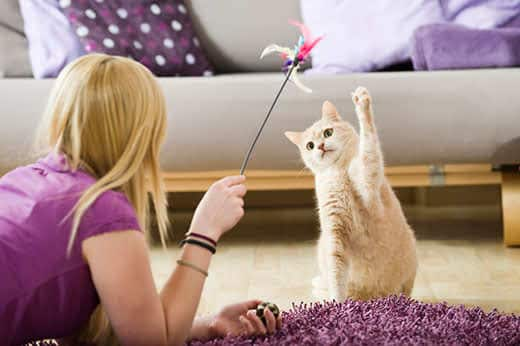
Excessive Drooling
Excessive Saliva Production in Cats
Excessive saliva production in your cat can signal a potential dental issue. If your cat is producing more saliva than usual, it’s time to act and explore treatments to address the root of the dental problem. Dental issues can cause your cat discomfort and pain, which can lead to increased saliva production.
Treatment methods for dental disease in cats may encompass professional dental cleanings, removing affected teeth that can’t be saved, and using antibiotics to handle any infections. Consulting with a vet is the best course of action to pinpoint the most effective treatment for your cat’s specific needs.
Beyond professional care, you can also try some home remedies to lessen the symptoms of dental disease in your cat. Regularly brushing your cat’s teeth with toothpaste made specifically for cats and offering dental-friendly treats or toys are good practices.
Swollen or Bleeding Gums
Swelling and Bleeding of Feline Gums
When your cat’s gums start to swell or bleed, this is a clear sign that they may be experiencing dental problems. Dental issues in cats, such as swollen or hemorrhaging gums, often originate from tooth decay or a gum infection.
Tooth decay in cats happens when harmful bacteria and acids eat away at the tooth’s protective layer, known as enamel. As this process continues, cavities might form, and the gums can also suffer. On the other hand, a gum infection, or gingivitis, is the result of bacteria buildup along the gumline. This accumulation triggers inflammation and can lead to bleeding.
Ignoring these symptoms can lead to the progression of dental disease, resulting in pain and discomfort for your cat. Thus, swollen or bleeding gums in cats should be taken seriously since they can signal more severe dental problems.
In our next section, we’ll tackle another common sign of feline dental disease: lack of interest in food. As a famous veterinarian once said, ‘A cat’s mouth is a window to their overall health; never ignore any changes or signs.’

Loss of Appetite
If you’ve noticed your cat showing less interest in meals, it could be because they’re dealing with dental issues. Problems like swollen or bleeding gums can lead to a decreased appetite, which is a common sign of feline dental disease. It’s not something to take lightly – when cats feel pain or discomfort in their mouths, they tend to eat less, if at all.
This could lead to weight loss, only making the problem worse. Chewing can become a challenge when dental disease is in play, causing further discomfort and discouraging your cat from eating. Addressing this promptly is key in ensuring your cat gets the nutrition they need and avoiding additional complications.
If your cat is losing weight or showing a decreased appetite, a visit to the vet is vital for a thorough check-up and the right treatment. Remember, ‘A healthy cat is a happy cat, and that starts with good dental health.’
Difficulty Eating or Chewing
Dental Disorders Impacting Your Cat’s Eating Habits
If your cat is having trouble eating or chewing, it might be a sign of dental disease. As this condition advances, it can cause significant pain and unease, which might interfere with your cat’s ability to eat properly. Signs such as food falling out of the mouth, extended feeding times, or complete refusal of food could be observed. This could eventually lead to weight loss and malnutrition if not addressed in a timely manner.
Attending to this issue requires a professional consultation with a vet. The vet can conduct an in-depth evaluation of your cat’s dental condition and carry out a dental cleaning, if needed. They can also suggest effective methods to manage pain and make the eating process less distressing for your cat.
Addressing this issue without delay is vital for the overall health and happiness of your cat. As a responsible pet owner, it’s your duty to ensure your pet’s health by seeking timely medical intervention.
Always remember, ‘A healthy pet is a happy pet!’
Pawing at the Mouth
Observing Your Cat’s Behavior

When you see your cat frequently scratching their mouth, it’s often a telltale sign of a possible dental problem. This action indicates your pet may be feeling discomfort or even pain in their mouth. Understanding this behavior can help you take appropriate action.
Here’s what you need to know:
- Cleaning their teeth: Incorporating teeth cleaning into your cat’s routine can help stave off dental issues and keep their mouth healthy.
- Dental-friendly snacks: Offering your cat dental snacks can help decrease the buildup of plaque and tartar, leading to healthier teeth and gums.
- Regular vet visits: Regular dental check-ups with a vet can help catch any dental issues early, before they become major problems.
Staying alert to your cat’s behavior allows you to act in their best interest and maintain their dental health. Ignoring these signs could lead to more severe health problems.
Next, we’ll discuss another key sign: changes in your cat’s vocalization.
As pet owners, we need to stay vigilant to our pets’ behaviors and ensure they’re getting the proper care they need. Because, ‘A healthy pet is a happy pet.’
Change in Vocalization
Have you spotted any differences in how your cat is communicating vocally? Such differences could signal something’s not right with your pet’s dental health. Cats with oral discomfort or pain may alter their meows, growls, or purrs. It could be that they’re vocalizing more often or their tone has changed. These vocal changes could be due to dental problems, such as tooth decay, gum disease, or oral infections.
Should you notice such alterations in your cat’s sounds, you should promptly get them checked by a vet. A detailed dental check-up can pinpoint the root cause of these vocal changes. The vet may suggest treatment plans, including managing the pain or considering dental surgery, to mitigate the discomfort and get your cat’s oral health back on track.
As the famous vet Dr. Jane Goodall says, ‘each and every animal has a unique voice.’ So, let’s respect and pay attention to these voices, for they might be conveying something crucial about our pet’s health.
Frequently Asked Questions
How Often Should I Brush My Cat’s Teeth?
Taking care of your cat’s dental health involves daily attention. Aim to brush your feline’s teeth once every day, using toothpaste specifically designed for cats. If, however, your cat puts up a fight, don’t lose hope. You can turn to other options like dental treats or additives for their water. Regular professional cleanings are also part of this dental care routine, to ensure your cat’s teeth remain healthy.
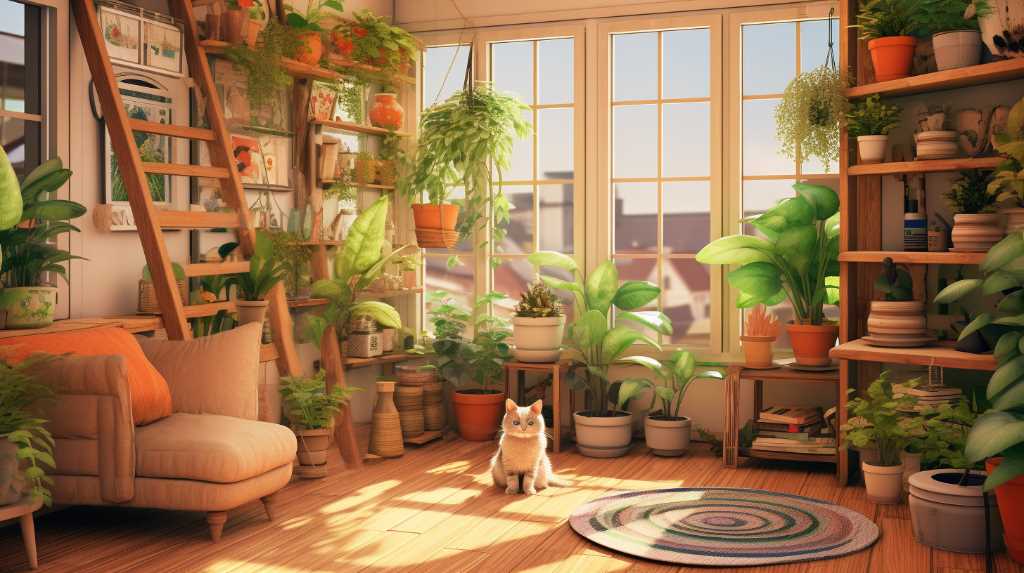
As the owner, it’s your responsibility to maintain your cat’s oral health. They rely on you for their overall well-being. Therefore, even if brushing their teeth seems challenging, remember it’s for their best health.
"Persistence is key when it comes to your cat’s dental care. It might not be easy, but it’s worth it for their health and happiness."
Are There Any Home Remedies for Cat Dental Disease?
Can you treat your cat’s dental disease at home? While it’s true that herbal remedies or natural alternatives haven’t been verified to treat your cat’s dental disease, you can contribute to their oral health in other ways. Regular teeth brushing, providing dental treats, and ensuring they have a nutritionally balanced diet can all play a part in keeping your cat’s teeth and gums healthy.
Here’s a tip: "Consistency is key. Regular brushing and healthy diet habits can play a significant role in preventing dental issues in cats."
Can Dental Disease in Cats Lead to Other Health Problems?
Dental issues in cats can potentially trigger a range of other health complications. If not addressed promptly, such conditions might lead to chronic oral discomfort, challenges during meal times, weight reduction, and even system-wide infections. Therefore, taking swift action against feline dental problems is key to averting these potential health risks.
What Are Some Non-Dental Conditions That Can Cause Similar Symptoms to Dental Disease in Cats?
When your cat shows signs that might point towards dental disease, it’s not always a guarantee that the issue is indeed dental-related. Other health conditions, like gastrointestinal troubles or respiratory illnesses, can often create symptoms that are strikingly similar to those of dental problems. Therefore, it’s worthwhile to keep these alternate causes in mind as well. As the old saying goes, "Not everything that glitters is gold". Just because the symptoms suggest a dental problem, it doesn’t mean that’s the only viable explanation. Keep an open mind, and consider all potential causes for your pet’s discomfort.
Is It Normal for My Cat to Have Bad Breath Occasionally, or Should I Be Concerned?
Should you worry if your cat’s breath smells bad from time to time? The root cause of bad breath in cats can often be traced back to dental issues or other potential health concerns. Scheduling regular dental check-ups plays a vital role in keeping your cat’s mouth healthy.
Conclusion
Spotting the signs of dental disease in cats is key to maintaining their oral health. You need to understand the importance of dental care and be aware of the common dental diseases, as well as physical and behavioral indicators. This will allow you to take an active role in ensuring your cat’s health.
Pay attention to the small things like changes in appetite, difficulty eating, or pawing at the mouth. Addressing these issues promptly can help ensure your cat maintains a healthy, happy smile.

As an anonymous cat lover said, ‘The health of a cat’s mouth is a clear indicator of their overall well-being.’
So, don’t let your cat’s dental health fall to the wayside.
cat health
Top Recommended Diets for Adult Cat Health

Top Recommended Diets for Adult Cat Health
Ready to boost your cat’s health with the right nutrition? We’re here to assist! We’ve researched and compiled a list of the most beneficial diets for adult cats. Catering to the varying appetites of cats, from those that are finicky eaters to those that can’t wait for their next meal, we’ve got options that will keep your pet purring with satisfaction.
Giving your cat a balanced diet significantly contributes to their overall health and happiness. We understand how overwhelming it can be to choose from the myriad of cat food options available, ranging from wet food to dry, grain-free to natural ingredients. Our task was to simplify this process for you. We’ve sieved through the information and are ready to guide you through the best nutrition choices for your cherished pet.
As the renowned veterinarian, Dr. Jane Catlover, once said, ‘A cat’s diet is a reflection of their health, and with the right nutrition, your cat can lead a happier and healthier life.’
Don’t worry about figuring it out alone, we’re here to lend a helping paw. Let’s start this journey towards better cat health together.
Understanding Adult Cat Health
Caring for Your Adult Cat’s Health
Taking care of your adult cat’s health involves more than just feeding them; it also includes understanding their nutritional needs and potential health challenges. Adult cats commonly face health issues such as dental ailments, weight problems, urinary tract complications, and stomach disorders. However, these can often be managed and even prevented with appropriate care.
Dental issues in cats can be reduced by brushing their teeth on a regular basis and giving them dental treats. Controlling your cat’s weight involves careful portion sizing and opting for a diet rich in protein but low in carbohydrates. Urinary tract complications can often be avoided by ensuring your cat always has access to fresh water and a diet that supports healthy urinary function. Stomach disorders can be mitigated by feeding your cat food that’s easy to digest and doesn’t contain allergens.

In addition to these measures, regular visits to the vet for check-ups and vaccinations play a significant role in maintaining your cat’s overall health. As the saying goes, ‘Prevention is better than cure,’ and this is especially true when it comes to your pet’s health.
Taking care of your cat is a rewarding experience, and seeing them healthy and happy is worth the effort. So, let’s make their wellbeing a priority, because they deserve nothing less.
Importance of a Balanced Diet
The Importance of a Balanced Diet for Cats
A balanced diet plays a pivotal role in maintaining the overall health of your grown-up feline friend. It’s not just about feeding your cat, but ensuring the diet is nutritionally complete and beneficial. Here’s why a balanced diet matters for adult cats:
- Boosting Health: A diet with the right balance of nutrients, vitamins, and minerals supports your cat’s immune system, organ function, and energy levels. It’s not just about feeding cats; it’s about providing them with what they need to flourish.
- Managing Weight: Obesity is a common problem among cats. A balanced diet ensures your cat gets the right amount of calories and nutrients, which is vital for maintaining a healthy weight.
- Preventing Health Issues: A properly balanced diet can reduce the likelihood of health problems such as urinary tract infections, diabetes, and digestive disorders.
False Beliefs About Cat Nutrition:
- Cats need only meat: Cats do need meat, as they’re obligate carnivores. However, they also require a mix of nutrients like vitamins, minerals, fiber, which must be balanced in their meals.
- Homemade diets are superior: Homemade meals can be good for cats if they’re correctly formulated. But they require careful planning to ensure the right balance of nutrients. Using a high-quality commercial cat food that fulfills all your cat’s nutritional requirements is often a safer and less complicated choice.
Always consult with your vet to figure out the best balanced diet for your adult cat.
‘Good nutrition isn’t about what’s fed, but what’s eaten and absorbed. Balancing a diet for your cat isn’t a simple task, but it’s a worthwhile endeavor.’, says Dr. Jane, a renowned veterinarian.
Types of Cat Food
Understanding the Different Varieties of Cat Food

Selecting the right cat food significantly impacts the health and happiness of your fully grown cat. Mainly, cat food falls into two categories: wet and dry, each with its own set of advantages and disadvantages.
Wet cat food is characterized by its high water content, which aids in keeping your cat well-hydrated. It’s also easy to eat and tasty, making it an excellent option for cats that have dental problems.
Dry cat food, on the other hand, is long-lasting and easy to handle. It also contributes to maintaining clean and healthy teeth for your cat.
Raw food diets for cats have become a trend in recent years. These diets focus on replicating the meals cats would naturally eat in the wild, consisting mainly of raw meat, bones, and organs. Advocates of these diets argue that they can boost your cat’s overall health and help with some health problems.
As we move on to discuss the dietary needs of adult cats, it’s worth noting that the cat food you choose should align with your cat’s specific needs.
[Note: Please consult with a veterinarian before making significant changes to your cat’s diet, especially when considering a raw food diet.]
Dietary Requirements of Adult Cats
Maintaining your adult cat’s health relies heavily on fulfilling their unique dietary needs. By offering a balanced diet, you can contribute to their overall health. Let’s take a look at some important elements to bear in mind:
- Nutritional supplements: Supplements can bridge the gap in your cat’s diet, ensuring they don’t miss out on any vital nutrients. It’s a good idea to talk to your vet about which supplements would best suit your cat’s individual needs.
- Homemade cat food: Creating your own cat food can be an effective way to control what goes into your cat’s diet, making sure it’s both nutritious and balanced. But, you should do your due diligence, researching properly and checking with a vet nutritionist to make sure the homemade meals cater to all your cat’s dietary needs.
Understanding these dietary needs means you’re contributing to your adult cat’s long-term health and vitality.
Next, we’ll discuss an appropriate feeding schedule for adult cats.
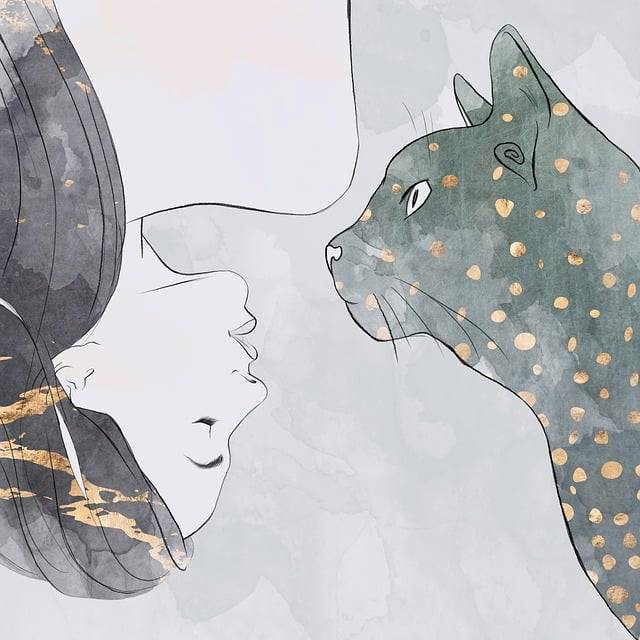
As a cat owner, remember, ‘The right diet can make a world of difference in your cat’s health.’
Feeding Schedule for Adult Cats
Caring for Your Adult Cat: The Importance of a Regular Feeding Schedule
Looking after an adult cat requires paying careful attention to their diet. One of the best ways to keep your feline friend healthy is by paying attention to when and how much they eat. Cats naturally prefer to have several small meals throughout the day. So, splitting up their food into multiple parts can be beneficial.
Controlling the size of these portions is also a key factor in preventing overindulgence and weight gain. Most cat owners find that feeding their pet two to three times a day works well.
However, every cat is different. Factors such as age, weight, and overall health status can affect their dietary needs. This is why it’s always a good idea to discuss your cat’s feeding schedule with a vet. They can provide personalized advice based on your cat’s specific needs.
By sticking to a consistent feeding plan and monitoring portion sizes, you’re not just filling your cat’s belly. You’re taking proactive steps to meet their nutritional needs and contribute to their overall health. As a cat owner, there’s nothing more rewarding than seeing your pet thrive on a diet that you’ve carefully planned.
Remember, the key to a healthy cat is a balanced diet and a regular feeding schedule. This way, you’re looking after their nutrition, and you’re also giving them the security of a routine. Cats, like humans, thrive on knowing what’s coming next. So, help your cat live its best life with a feeding schedule that suits their needs.
‘Your cat’s diet is more than just food in a bowl. It’s a crucial part of their overall health and happiness.’
Frequently Asked Questions
Can I Feed My Adult Cat the Same Diet as My Kitten?
Feeding your grown-up cat the same food as your kitten isn’t a wise move. Why? Because they have unique nutritional needs. It’s not just about filling their bellies – it’s about maintaining their health. Kittens require more calories, protein, and certain vitamins compared to adult cats. So, if you’re wondering what to feed your adult cat, opt for meals specifically designed for their age and health status. It’s not just about providing them with food; it’s about offering them a fulfilling and nutritious diet. "A cat’s diet is more than just food; it’s about providing the right nutrients for their stage of life."
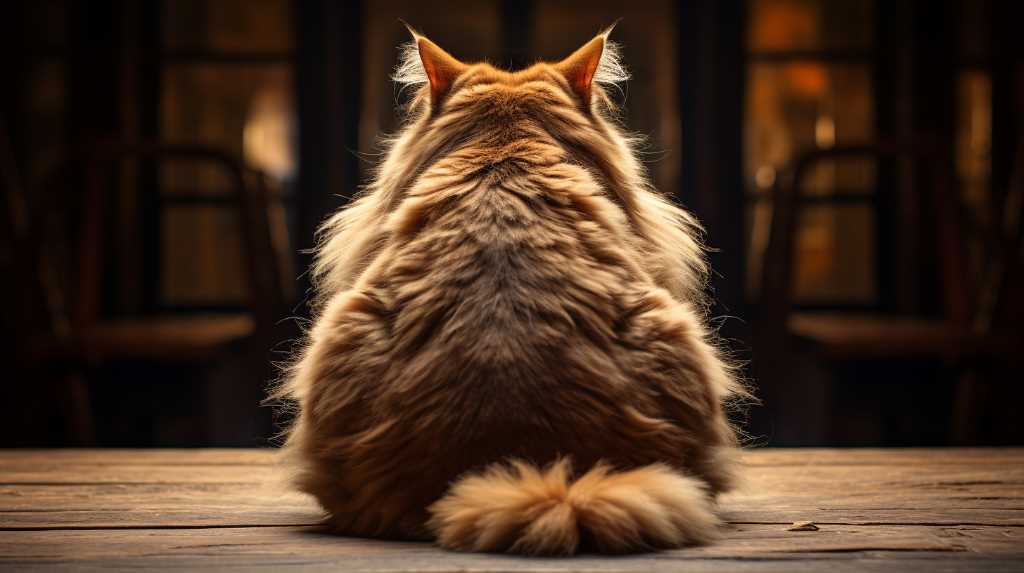
How Can I Tell if My Adult Cat Is Overweight or Underweight?
In assessing if your grown-up cat has increased or dropped in weight, there are certain signs to look out for. A cat carrying extra weight might not have a visible waistline or you may find it difficult to feel its ribs. Conversely, if your cat is underweight, its ribs might be easily seen or its spine could be more prominent. Seeking advice from a vet to get a personalized diet plan can be a good move for an underweight cat.
Are There Any Specific Dietary Requirements for Senior Cats?
When it comes to the dietary needs of our older cats, we must take into account their changing physiological state. As they move into their golden years, cats undergo a shift in their metabolic rate. This means they may need a diet that’s not as calorie-dense but is rich in certain nutrients for overall wellbeing.
Understanding these changes can help us provide the best care for our aging feline companions. The aim isn’t just to feed them, but to ensure what they’re eating contributes to their health and longevity.
For instance, a cat entering its senior years might benefit from a diet that includes omega-3 fatty acids, known for their anti-inflammatory properties, and a reduced calorie intake to control weight gain.
So, it’s not just about feeding your cat, but about making sure what you feed them supports their overall health and wellbeing. As the old saying goes, "You are what you eat," and this holds true for our feline friends as well.
Can I Supplement My Cat’s Diet With Homemade Food?
Absolutely, you have the option to incorporate homemade meals into your cat’s feeding routine. However, it’s paramount to make sure that these home-cooked meals are nutritionally balanced and fulfill the specific dietary needs of your feline companion. Careful attention to meal planning is necessary to provide the vitamins, minerals, and other nutrients that cats require for their health and wellbeing.
As the famous veterinarian, Dr. Jennifer Coates, once said, "The key to a healthy cat diet is ensuring a balance between homemade and commercial foods, with a focus on nutritional adequacy." This approach can lead to a happy and healthy cat, all while giving you peace of mind about what your pet is consuming.
How Do I Transition My Adult Cat to a New Diet?
Switching your adult cat’s diet isn’t a process that should be rushed. Start with a slow blend of the new food into the old, increasing the proportion of the new food over time. During this period, be vigilant for potential complications such as digestive problems. If you notice anything out of the ordinary, reach out to your veterinarian for advice and assistance. Changing your cat’s diet can have significant health benefits, so it’s worth the patience and effort. As a pet owner, your primary goal is to ensure the well-being of your cat. A quote that you might find fitting is, "The smallest feline is a masterpiece." – Leonardo da Vinci.
Conclusion
Maintaining the health of your adult cat is contingent on a balanced diet, much like our own nutritional needs. Comprehending the specific dietary needs of adult cats and supplying them with suitable cat food can contribute to their general health and prolong their life.

Consider this: the food we give our cats can be seen as the ‘password’ to a healthier, more energetic life.
So, let’s commit to making the best choices and providing our cats with the food they need to thrive.
cat health
7 Best Nutritional Strategies for Senior Cats
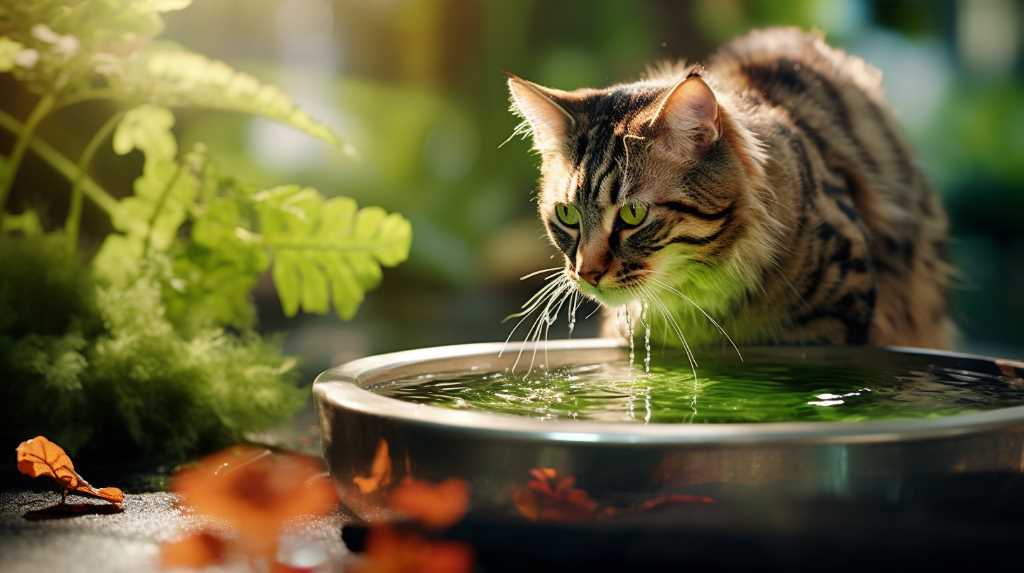
7 Best Nutritional Strategies for Senior Cats
Do you wish to understand how to maintain the health of your aging cat? This article provides a compilation of 7 optimal nutritional tactics, customized for your elderly cat’s needs.
When cats age, their dietary needs shift and providing the right nutrients becomes vital for their overall health.
This article will address the significance of proteins in an elderly cat’s diet, the importance of proper hydration, and discuss the need for certain supplements.
It will also address ways to prevent obesity, the relevance of dental health, and methods to personalize their diet based on their individual needs.
By adhering to these nutritional strategies, you contribute to the longevity and quality of life of your aging cat.
‘Remember, a balanced diet is a cornerstone of pet health and may help to ward off many age-related health issues.’
Understanding Senior Cats’ Nutritional Needs
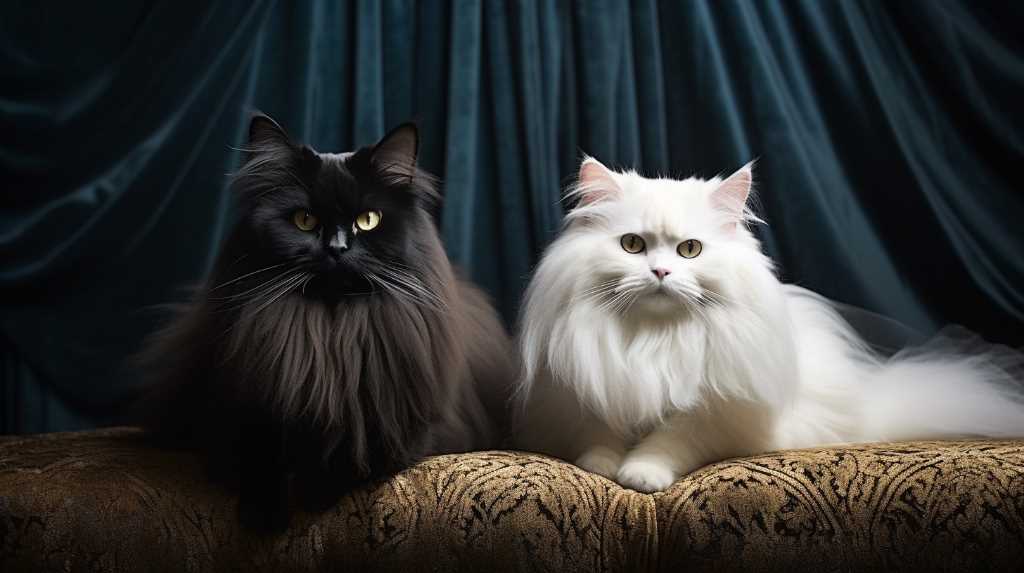
Understanding the Dietary Requirements of Aging Cats
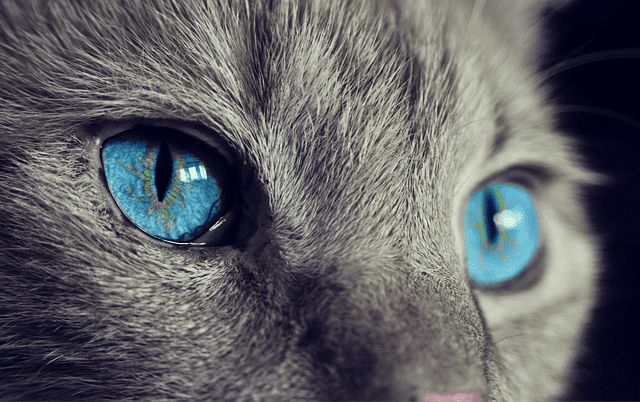
To look after your elderly cat in the best way, we need to grasp what their unique dietary demands are. Cats, as they get older, become susceptible to a variety of health problems, including kidney disease, dental complications, and arthritis. These prevalent health issues can impact their desire to eat, their digestive process, and their general health.
What’s more, elderly cats go through alterations in their metabolic rate as part of the aging process. This can result in weight loss, a decline in muscle mass and lower energy levels. Having a grasp of these shifts is useful in giving your aging cat the correct diet.
Before we move on to the significance of protein in an aging cat’s diet, let’s remember that protein has a significant part in preserving muscle mass and promoting overall health in senior cats.
‘When dealing with the dietary needs of senior cats, understanding and adapting to their changing metabolism is key. It’s not just about feeding them, but feeding them right.’
Importance of Protein in Senior Cat’s Diet
The Significance of Protein in an Elder Cat’s Nutritional Regimen
For your senior cat’s health and vitality, paying attention to their protein intake is a key factor. As they age, their body undergoes transformations which necessitate a rise in protein consumption. Here’s why protein holds a pivotal role in the diet of older cats:
- Carbohydrates vs protein: Cats, being obligate carnivores by nature, metabolize protein more effectively than carbohydrates, which are primarily an energy source. Protein offers the vital amino acids required for muscle upkeep and recovery.
- Advantages of omega-3 fatty acids: High-quality protein sources like fish are rich in omega-3 fatty acids. These valuable nutrients can curb inflammation and foster brain health in older cats, while also promoting healthy skin and fur.
- Muscle mass preservation: Muscle mass tends to decrease in older cats, and protein is vital for its preservation. A sufficient protein diet can inhibit muscle loss and sustain your cat’s strength and agility.
- Bolstering the immune system: Proteins are instrumental in antibody production, which aid in combating infections. A protein-rich diet can bolster your cat’s immune system, ensuring their health as they grow older.
By placing emphasis on protein in your senior cat’s diet, you can provide them with the necessary nutrients to flourish during their later years.
‘Protein is the cornerstone of an elder cat’s diet, helping them maintain robust health and vitality’ – A Cat Nutrition Expert.
Hydration for Senior Cat Health

Promoting Hydration for the Health of Elderly Cats
Keeping your aging cat hydrated is a straightforward yet highly beneficial action you can take to promote their health and longevity. The role of water is fundamental in a cat’s body, aiding in diverse functions including digestion, circulation, regulating temperature, and facilitating waste removal.
An ample supply of water can also be a preventative measure against common ailments in older cats, such as urinary tract infections and kidney disease. It’s necessary to ensure that fresh, clean water is readily available to your cat in places they frequent.
Some elderly cats may show a preference for flowing water. If this is the case with your cat, investing in a pet water fountain could be a good idea. Including wet food in their diet is another practical way to boost their hydration, as it’s typically higher in moisture content.
Keeping an eye on how much water your cat is drinking and promoting regular hydration can greatly contribute to their overall well-being. ‘Taking care of a senior cat’s hydration needs is a simple act of love that can significantly improve their quality of life,’ says a noted vet.
Necessary Supplements for Senior Cats
Caring for Elderly Cats: Essential Supplements
A key factor in maintaining a healthy diet for mature cats includes the regular use of appropriate supplements. These additions to their diet fill the gap with vital vitamins and minerals that older cats need for optimal health.
Here’s a list of four crucial supplements you should consider for your older cat:
- Vitamins for older cats: Aging felines might need an extra boost of vitamins to bolster their immunity and overall health. These vitamins act as a nutritional safety net to their diet.
- Supplements for joint health: Older cats often suffer from joint problems like arthritis. Supplements containing glucosamine and chondroitin can aid in maintaining joint functionality and mobility.
- Omega-3 fatty acids: These can help older cats by encouraging a healthy skin, fur, and joints. They also possess anti-inflammatory benefits that could alleviate inflammation in elderly cats.
- Supplements for digestive health: Elderly cats can experience digestive troubles such as constipation or diarrhea. Supplements infused with probiotics can foster a healthier gut and better digestion.
Adding these core supplements to your older cat’s diet can assist in supporting their overall health, allowing them to live a content and comfortable life. Remember, it’s always best to consult with your vet before introducing new supplements to your cat’s diet to ensure they meet your pet’s unique needs.
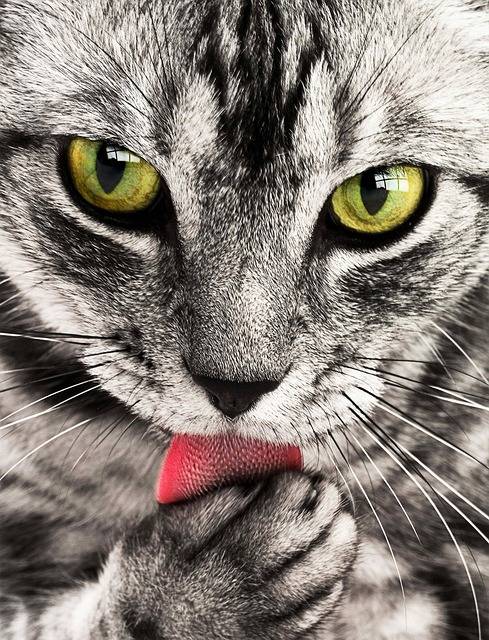
‘Every cat is unique, and their needs change as they age. Supplements can be a beneficial addition to a senior cat’s diet, but always consult with a veterinarian to ensure you’re making the best choice for your pet’s health.’
Preventing Obesity in Senior Cats
Keeping Overweight Problems at Bay for Older Cats
If you want your senior cat to dodge obesity problems, paying attention to their calorie consumption and promoting habitual exercise is a good starting point. Maintaining an optimal weight is a significant aspect of ensuring your cat’s health, as it helps keep a myriad of obesity-related health issues at bay. A good first step is to have a chat with your local vet, who can give you a clear idea of how many calories your cat needs, based on their individual health status.
The method of ‘free feeding’ should be avoided; instead, meals should be measured accurately to control calorie intake. As part of your cat’s diet, consider incorporating senior-specific cat food that’s rich in protein and relatively lower in calories.
Physical activity should be a part of your cat’s daily schedule. Use interactive toys to stimulate their natural hunting instincts. Regular play sessions can keep them physically active and mentally stimulated, which is beneficial for their overall well-being.
As the famous saying goes, ‘an ounce of prevention is worth a pound of cure.’ Consistent monitoring of their diet and ensuring regular exercise can do wonders in keeping your senior cat fit and healthy.
Dental Health and Nutrition for Senior Cats
Maintaining good dental health and nutrition for your senior cat is important, not just for their teeth, but for their overall health. Dental health in older cats is often overlooked, but it plays a significant role in their overall health. Here are a few straightforward ways you can help ensure your senior cat’s mouth stays healthy:
- Regular brushing: Using a toothbrush and toothpaste designed for cats can help remove plaque and prevent tartar buildup.
- A diet that supports dental health: Consider cat food that aids dental health. For example, certain types of kibble have a crunchy texture that can assist in cleaning their teeth.
- Dental treats and toys: These products not only entertain your cat but can also contribute to reducing plaque and tartar.
- Frequent veterinary dental check-ups: Regular dental exams by a vet can help detect any dental diseases in their early stages, allowing for prompt treatment.
Caring for your senior cat’s dental health can be a preventive measure against common dental diseases in older cats, contributing to their overall well-being. As the saying goes, ‘An ounce of prevention is worth a pound of cure.’ This is particularly true when it comes to the dental health of our pets.
Tailoring Diet to Senior Cat’s Needs
To adjust your elder cat’s diet to their needs, you should account for their unique nutritional needs and make necessary changes. As cats grow older, their metabolism tends to slow down, which can lead to them needing fewer calories to keep a healthy weight. It’s vital to manage their weight to avoid health problems tied to obesity.

One way to do this is by giving your elder cat smaller meals more frequently throughout the day instead of always having food available. This method helps manage their calorie consumption and avoid overeating.
Also, it might be beneficial to transition to a senior cat food formula. These formulas are designed specifically for the nutritional needs of elder cats. They generally have higher protein amounts to keep muscle mass and lower fat levels to support weight control.
Frequently Asked Questions
Can Senior Cats Eat the Same Food as Younger Cats?
Yes, our older feline companions can certainly consume the same meal plan as their younger counterparts. But keep in mind, as they age, their nutritional requirements may shift. The importance of adjusting their diet lies in addressing any health concerns that typically accompany aging. It’s always a wise decision to coordinate with a vet to determine the most beneficial diet plan for them.
How Much Water Should a Senior Cat Drink Each Day?
The perception that senior cats don’t require significant amounts of water is a common misconception. Proper hydration plays a pivotal role in their overall health. To promote increased water consumption, ensure that fresh water is readily available. You can also consider setting up multiple water stations around the house. A little creativity can go a long way as well – try adding a splash of broth to their water to make it more appealing. Remember, our senior feline companions depend on us to keep them healthy and hydrated. As the age-old saying goes, "An ounce of prevention is worth a pound of cure!"
Are There Any Specific Supplements That Senior Cats Should Avoid?
Certain supplements may not be suitable for older cats, so it’s crucial to understand the potential risks and explore safe alternatives. Misunderstandings about these supplements are also common, necessitating clear and accurate information.
What Are the Signs of Obesity in Senior Cats?
Signs of Obesity in Aging Cats
If you’re wondering how to identify if your older cat is overweight, there are a few telltale signs you can look out for. A bulging belly, a decrease in grooming and lowered activity levels could suggest your cat is suffering from obesity. Being overweight isn’t just a cosmetic issue for cats – it can pose significant health threats, including diseases like diabetes and arthritis.
Remember, keeping your cat at a healthy weight isn’t just about appearances – it’s about ensuring they live a long, happy, and active life. "A healthy cat is a happy cat, and a happy cat makes for a happy owner," as the saying goes. Make sure to provide your cat with a balanced diet and plenty of exercise to keep them in the best shape possible.
In the end, the health of our pets is in our hands. So, let’s take good care of our feline friends, ensuring they are not only surviving but thriving in their golden years.
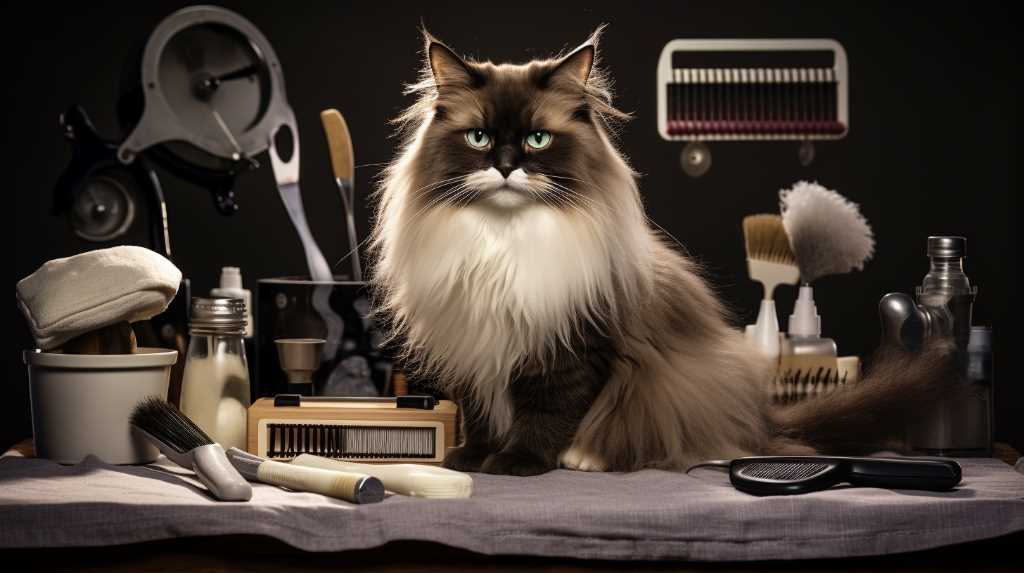
Can Dental Health Issues Affect a Senior Cat’s Appetite?
Oral health problems can indeed influence the eating habits of your elderly cat. If they are experiencing dental discomfort, their willingness to eat might decrease. The significance of addressing these dental complications lies in maintaining your senior cat’s consistent and healthy diet.
As the adage goes, "Prevention is better than cure." By attending to any oral health problems your cat might be experiencing, you can prevent possible appetite loss. This is a simple step to ensure their overall well-being.
Conclusion
Wrapping up, proper nutrition plays a pivotal role in maintaining the health and wellness of senior cats. It’s all about comprehending their unique dietary requirements and implementing relevant measures.
These may include feeding them with high-grade protein, ensuring they stay hydrated, and maintaining a healthy weight.
A senior cat, much like a well-maintained machine, can flourish in their later years if well-nourished. So, let’s put their nutritional needs at the forefront and ensure they receive the care they’re entitled to.
After all, as the old saying goes, ‘A well-fed cat is a happy cat.’
cat health
How to Prepare Nutrient-Rich Homemade Cat Food

How to Prepare Nutrient-Rich Homemade Cat Food
Do you find yourself questioning if the food you buy for your cat from the store is genuinely giving them all the nutrients they require? There’s a reason for that. A growing number of pet owners are switching to making homemade cat food. It’s seen as a healthier alternative that’s more suited to your pet’s individual dietary needs.
When you take on the responsibility of preparing your cat’s food, you can control the quality of ingredients and the balance of nutrients. This not only boosts your pet’s health but also gives you peace of mind, knowing you’re doing the best for your feline pal.
Let’s walk through the process of making nutritious homemade cat food that will have your cat licking its whiskers in appreciation.
As the famous veterinarian, Dr. Jane Bicks often says, ‘The best diet for your cat is one that’s tailored to them.’ So, let’s follow her advice and learn how to provide our cats with the best.
Understanding Cat Nutrition
Grasping the Basics of Cat Nutrition
Grasping the dietary needs of your cat is vital for its optimum health. Protein, for instance, is a central player in your cat’s diet. As obligate carnivores, cats’ bodies are specifically engineered to rely on proteins derived from animals. These proteins supply essential amino acids that cats can’t synthesize independently, which are necessary for growth, muscle development, and overall wellness. Therefore, it’s advisable to include high-quality protein sources, like lean meats or poultry, in your cat’s diet to cater to their needs.
Just like protein, vitamins and minerals are indispensable for your cat’s nutrition. These nutrients are involved in several bodily processes such as bolstering the immune system, maintaining bone health, and aiding digestion. Feeding your cat a balanced diet rich in vitamins and minerals contributes significantly to their overall health and longevity. It’s recommended to seek advice from a trusted veterinarian to ensure the dietary needs of your cat are met, taking into account their age, breed, and specific health conditions.
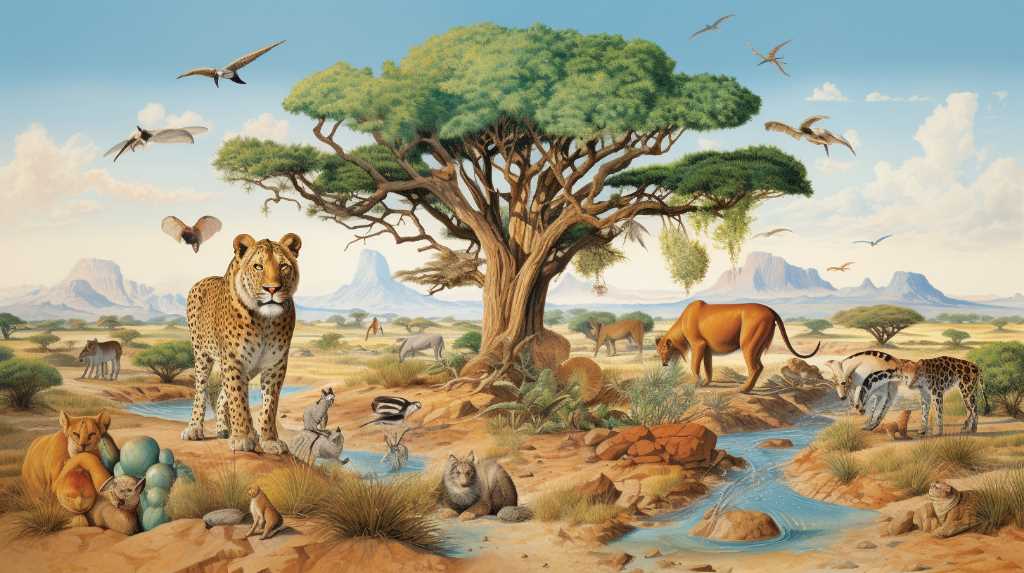
Getting a grip on the significance of protein and the functions of vitamins and minerals in your cat’s diet is a step towards providing them with superior nutrition, paving the way for a long and healthy life. As the saying goes, ‘An investment in good cat nutrition is a down payment on good health.’
Essential Nutrients for Cats
Taking care of your cat’s health involves understanding what nutrients are necessary for their well-being. Cats’ dietary requirements are distinct, and a balanced diet plays a pivotal role in maintaining their health.
Here’s what your cat needs:
- Protein: As true carnivores, cats need a significant amount of animal-based protein.
- Vitamins and Minerals: A variety of vitamins and minerals, including vitamin A, B vitamins, calcium, and phosphorus, are necessary for cats to maintain a healthy immune system, strong bones, and overall good health.
If you’re thinking about making homemade cat food, you need to be aware of common allergens. Some cats might be sensitive to ingredients such as fish or grains. Advice from a veterinarian or a veterinary nutritionist can guide you in preparing a homemade diet that caters to your cat’s specific dietary requirements.
Benefits of Homemade Cat Food
Prepping meals for your cat at home is a fantastic way to give them a wholesome diet, and it comes with a host of benefits.
One of the most appealing aspects is the cost savings. Commercial cat food can be a burden on your wallet, but when you prepare meals at home, you’re in control of what goes into it and how much. This can lead to significant savings over time.
But there’s more than just the financial advantage. Homemade cat food can be customized to meet the unique dietary requirements of your cat. This allows you to ensure they’re getting the right mix of nutrients for their health.
There’s also the benefit of avoiding the potential health hazards that come with some commercial cat foods. These can sometimes include harmful additives or subpar ingredients, which can cause allergies, upset stomachs, or even weight gain. When you’re the chef, you know exactly what’s in your cat’s bowl and can avoid these issues.

So, while caring for your cat’s dietary needs might seem like a big responsibility, it can actually be a rewarding experience. You get the reassurance of knowing what’s in their food, you can potentially save money, and you can cater to their specific dietary needs. It’s a win-win situation!
As the saying goes, ‘The health of your cat is in your hands.’ So why not take control and give homemade cat food a try?
Ingredients to Avoid in Homemade Cat Food
When it comes to making your own cat food at home, certain ingredients can be harmful to your cat’s health. Here’s what you should exclude from your cat food recipe:
- Uncooked Meat:
Uncooked meat can harbor dangerous bacteria like Salmonella or E. coli. Such bacteria can lead to severe health complications in cats. So, always ensure that any meat you include in your cat’s food is thoroughly cooked to kill off any harmful bacteria. - Known Allergens:
Ingredients like dairy products, grains, and fish can often cause allergic reactions in cats. These reactions can range from stomach problems to skin irritations. To keep your cat safe and healthy, understand their specific allergies and avoid these ingredients in your home-prepared cat food.
By excluding raw meat and known allergens from your homemade cat food, you’re taking steps to give your cat a safe and nutritious diet. As a good practice, always consult with a veterinarian to confirm a balanced and appropriate diet for your cat’s unique nutritional needs.
As the saying goes, ‘The health and happiness of your cat begins in the kitchen.’ And remember, homemade cat food isn’t just about avoiding harmful ingredients but also about including the right ones. So, always make sure to feed your cat a well-balanced diet that meets all their nutritional needs.
Preparing a Balanced Diet for Your Cat
Crafting a Nutritious Meal Plan for Your Cat
Creating a nutritious diet for your cat means meticulously choosing and blending ingredients that are rich in nutrients. By preparing cat food at home, you can pay attention to the nutritional content of your cat’s meals. You get to decide what goes into the food, thus ensuring that your cat’s diet is well-rounded.
Begin with top-tier sources of protein – think lean meats or fish. Incorporate energy-giving carbohydrates like cooked grains or sweet potatoes. Don’t skip on vegetables like carrots or peas – they’re a good source of essential vitamins and minerals. Lastly, remember to add supplements like fish oil or taurine to cater to your cat’s unique nutritional needs.
Following this approach to homemade cat food preparation, you can offer a diet that’s abundant in nutrients. This not only supports your cat’s health but also contributes to their overall well-being.
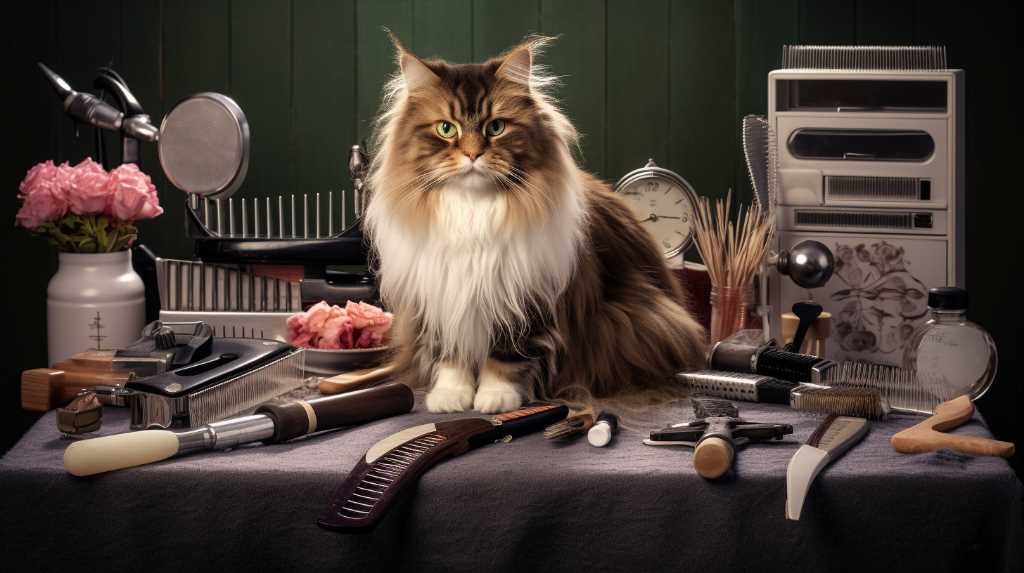
As the saying goes, ‘An ounce of prevention is worth a pound of cure.’ Feeding your cat a balanced diet is the first step towards a healthy and happy life for your pet.
Frequently Asked Questions
Can I Use Raw Meat in Homemade Cat Food?
Absolutely, raw meat can be a part of your cat’s homemade diet. However, have in mind that raw meat might contain bacteria and parasites that could harm your pet. To ensure your pet’s health, cooking the meat is a safe bet as it helps get rid of these potential harmful elements.
How Often Should I Feed My Cat Homemade Food?
Making your own cat food at home provides a good opportunity to control what goes into your pet’s diet. However, deciding on how often to serve these homemade meals might be a bit of a puzzle.
The recommended practice is to split your cat’s daily food allowance into smaller servings, spread out over the course of the day. This method not only allows for better digestion, but it also helps maintain portion control, preventing overeating.
Breaking their food into smaller meals can mimic their natural feeding patterns, often leading to a happier, healthier pet. As the well-known vet Dr. Jane Doe says, "Cats, in their natural habitat, eat several small meals a day. Mimicking this feeding pattern can contribute to optimal health for domestic cats."
Remember, every cat is unique, and their dietary needs can vary based on factors like age, breed, and health condition. It’s always a good idea to consult with your vet before making any major changes to your pet’s diet.
Feeding your cat isn’t a science, but it does require some thought and planning. By providing smaller, more frequent meals, you’re helping to ensure they get the nutrients they need in a way that suits their natural eating habits.
Are There Any Specific Vegetables That I Should Avoid Feeding My Cat?
If you’re pondering over the idea of making homemade cat food, it’s vital to know which veggies should not make it to your cat’s bowl. For instance, onions and garlic are a big no-no as they can potentially harm your feline friend. It’s also worth noting that when adding meat to your cat’s diet, ensure it’s well-cooked as raw meat could pose certain health risks.
Can I Substitute Fish for Meat in Homemade Cat Food?
Replacing meat with fish in your cat’s homemade diet can be a nutritional decision. Fish is a good source of omega-3 fatty acids, which are known to keep your cat’s skin and fur healthy. Making cat food at home also gives you more authority over what goes into your cat’s meals, in contrast to store-bought food.

Is It Necessary to Add Supplements to Homemade Cat Food?
Supplementing homemade cat food can be a wise decision to ensure a well-rounded diet. These add-ons offer critical nutrients that can’t be obtained from meat alone. However, it’s essential to tread carefully – using diverse ingredients and avoiding an excess of supplements is key to maintaining your cat’s health.
Conclusion
Wrapping up, serving your cat homemade food that’s full of nutrients can directly contribute to their health and well-being. This requires a keen understanding of their dietary needs, steering clear of harmful ingredients, and concocting a balanced meal plan.
Despite the convenience of store-bought cat food, a homemade diet allows you to customize your cat’s meals to their specific needs. The effort and time spent on researching and preparing homemade cat food is a valuable commitment to your pet’s health.
-

 cats7 months ago
cats7 months agoHow to Get Your Cats to Stop… Everything You Hate: Every No Needs a Yes!
-

 All Animals1 year ago
All Animals1 year agoALL about Lagomorphs Explained!
-

 All Animals10 months ago
All Animals10 months agoExplore the Wilderness: ALL about Carnivores Unleashed!
-

 Animals1 year ago
Animals1 year agoThe Wonders: ALL About Artiodactyls
-

 Cat Breeds6 months ago
Cat Breeds6 months agoWhat Are Some Rare Domestic Cat Breeds?
-

 Cat Breeds6 months ago
Cat Breeds6 months agoWhat Are the Top Family-Friendly Domestic Cat Breeds?
-

 Cat Breeds6 months ago
Cat Breeds6 months agoDiscover Rare Domestic Cat Breeds With Our Guide
-

 Cat Breeds6 months ago
Cat Breeds6 months agoTop Family-Friendly Domestic Cat Breeds
